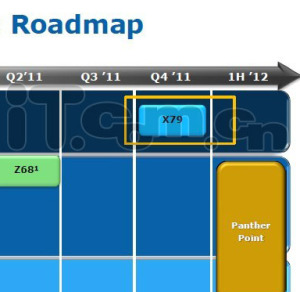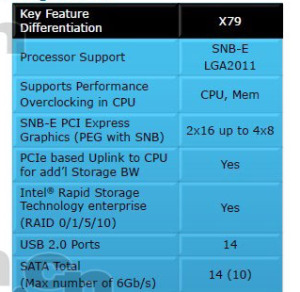
Chinese tech site IT.com.cn claims to have got hold of some leaked slides that detail Intel's forthcoming X79 chipset for LGA2011 systems. If the slides are genuine, then it looks as though X79 has a bazillion connections and could form the basis of a supercomputer.
According to the slides, the chipset supports up to 14 SATA ports, ten of which can support SATA 6Gbps while eight can support SAS (serial attached SCSI).
The slides also suggest that LGA2011 CPUs will have 32 lanes of PCI-E bandwidth, with either dual-16-lane or quad-8-lane graphics setups possible, while eight PCI-E 2.0 lanes connect the CPU to the chipset. There’s no mention of whether SLI and CrossFire will be supported, though, or whether the lanes will support PCI-E 3.0.
The latter isn’t too surprising, though, as it looks as though PCI-E 3.0 support won't turn up until the arrival of the Panther Point chipset for Ivy Bridge CPUs, and a second slide allegedly showing Intel’s roadmap suggests that the X79 chipset will pre-date Panther Point. Bizarrely, however, despite a cornucopia of internal high-speed connections, there’s no mention of USB 3 support yet.
According to the roadmap slide, the X79 chipset is currently scheduled to be launched in Q4 of 2011. We speculate that LGA2011 CPUs will be based on a super-charged Sandy Bridge design (hence the SNB-E codename), with 4- and 6-core models and quad-channel memory controllers. We presume it will also be fabricated using 32nm transistors like Sandy Bridge CPUs, as the next die-shrink isn't expected until the launch of Ivy Bridge.
So what say you? Is a 6-core CPU based on the Sandy Bridge microarchitecture overkill for anyone not running professional applications, or do you just want one anyway? Answers in the forum please.
Via VR-Zone.
According to the slides, the chipset supports up to 14 SATA ports, ten of which can support SATA 6Gbps while eight can support SAS (serial attached SCSI).
The slides also suggest that LGA2011 CPUs will have 32 lanes of PCI-E bandwidth, with either dual-16-lane or quad-8-lane graphics setups possible, while eight PCI-E 2.0 lanes connect the CPU to the chipset. There’s no mention of whether SLI and CrossFire will be supported, though, or whether the lanes will support PCI-E 3.0.
The latter isn’t too surprising, though, as it looks as though PCI-E 3.0 support won't turn up until the arrival of the Panther Point chipset for Ivy Bridge CPUs, and a second slide allegedly showing Intel’s roadmap suggests that the X79 chipset will pre-date Panther Point. Bizarrely, however, despite a cornucopia of internal high-speed connections, there’s no mention of USB 3 support yet.
According to the roadmap slide, the X79 chipset is currently scheduled to be launched in Q4 of 2011. We speculate that LGA2011 CPUs will be based on a super-charged Sandy Bridge design (hence the SNB-E codename), with 4- and 6-core models and quad-channel memory controllers. We presume it will also be fabricated using 32nm transistors like Sandy Bridge CPUs, as the next die-shrink isn't expected until the launch of Ivy Bridge.
So what say you? Is a 6-core CPU based on the Sandy Bridge microarchitecture overkill for anyone not running professional applications, or do you just want one anyway? Answers in the forum please.
Via VR-Zone.

MSI MPG Velox 100R Chassis Review
October 14 2021 | 15:04










Want to comment? Please log in.